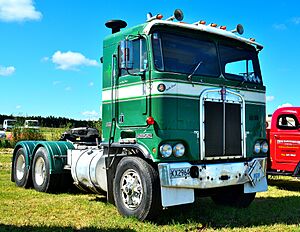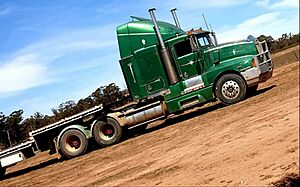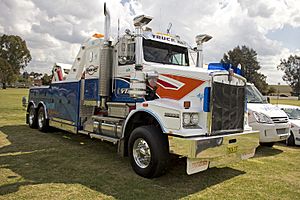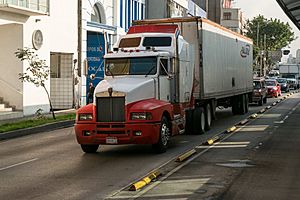Kenworth facts for kids

Kenworth "KW" emblem and name badge
|
|
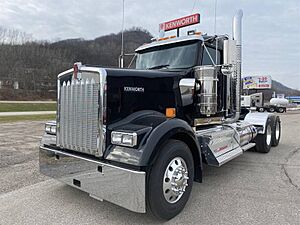
A Kenworth W900 – a family of models lettered W after founder, Edgar Worthington, whose name is the "worth" in Kenworth
|
|
| Division | |
| Industry | Manufacturing |
| Predecessor | Gersix Motor Company |
| Founded | 1923 in Seattle, Washington, U.S. |
| Founders | Harry Kent Edgar K. Worthington |
| Headquarters | Kirkland, Washington, U.S. |
| Products | See listing |
| Parent | PACCAR |

Kenworth Truck Company is a famous American company that makes trucks. It started in 1923 and builds big, strong trucks (called Class 8) and medium-sized trucks (Class 5–7). Kenworth's main office is in Kirkland, Washington, near Seattle. Since 1945, it has been part of a larger company called PACCAR, working alongside its sister company, Peterbilt Motors.
Kenworth has made some cool "firsts" in truck building. They were the first to make a truck with a raised roof for the sleeping area. They also made the first heavy-duty truck designed to cut through the air better, saving fuel. The Kenworth W900 truck has been made since 1961, which is one of the longest times any truck model has been in production! The K100 also came out in 1961.
Contents
- History of Kenworth Trucks
- Early Days: Gerlinger Motors (1912-1923)
- Becoming Kenworth Motor Truck Company (1923-1930s)
- War Production and New Ownership (1940s)
- Growing Bigger (1950s)
- The Famous W900 and K100 (1960s)
- More Trucks and New Names (1970s)
- Modern Designs and New Models (1980s-1990s)
- 21st-Century Trucks (2000s-Present)
- Current Kenworth Models
- Where Kenworth Trucks Are Made
- Kenworth's Bus Production (A Brief Look)
- Images for kids
- See also
History of Kenworth Trucks
Early Days: Gerlinger Motors (1912-1923)
Kenworth's story began in 1912 with Gerlinger Motors in Portland, Oregon. This company, owned by brothers George and Louis Gerlinger, sold cars and trucks. In 1914, they started building their own truck called the Gersix. It was named "Gersix" because it had a six-cylinder engine, which was new for trucks then. The Gersix was built very strong, perfect for tough jobs like logging.
The Gersix trucks became popular, especially with loggers in the Northwest. In 1916, Gerlinger Motors moved to Tacoma, Washington. A businessman named Edgar K. Worthington bought the company in 1917 with his partner, Captain Frederick Kent. They renamed it Gersix Motor Company. In 1919, Captain Kent's son, Harry Kent, joined as a partner.
By 1922, Gersix was doing well, making 53 trucks that year. They had enough money to start a new company and move to a bigger place.
Becoming Kenworth Motor Truck Company (1923-1930s)
In January 1923, Gersix Motor Company became the Kenworth Motor Truck Company. The name "Kenworth" comes from the last names of the partners: Kent and Worthington. The company moved to a new factory in Seattle. Unlike car makers, Kenworth didn't use assembly lines. They built each truck by hand in separate areas. They also started building trucks exactly how customers wanted them, a practice Kenworth still does today!
In 1926, Kenworth started making buses. By 1927, they were building three vehicles a week. They even started making trucks in Canada to avoid extra taxes.
Harry Kent became president in 1929 when Edgar Worthington retired. The Great Depression made things tough for the company. To keep going, Kenworth started making fire trucks in 1932. These were some of the strongest fire trucks around.
In 1933, Kenworth trucks started using diesel engines instead of gasoline engines because diesel was much cheaper. They also introduced the first factory-made "sleeper cab," a small room behind the driver's seat where drivers could rest.
New laws in 1935 changed how big and heavy trucks could be. Kenworth had to redesign its trucks to follow these rules. They used lighter materials like aluminum for cabs and added new suspension systems. In 1936, Kenworth introduced its first "cabover" (COE) truck, where the driver's cab sits over the engine. Harry Kent passed away in 1937, and Philip Johnson became the new president.
War Production and New Ownership (1940s)
By the end of the 1930s, truck sales started to get better. In 1940, Kenworth made 226 trucks. When World War II began, Kenworth switched to making vehicles for the war effort. They built recovery vehicles for the Army and even parts for Boeing's B-17 and B-29 bombers. To make so many vehicles, Kenworth started using an assembly line for the first time.
In 1944, company president Phil Johnson died. The owners decided to sell the company. In 1945, Pacific Car and Foundry Company bought Kenworth, making it a part of their larger business. Kenworth moved to a new, bigger factory in Seattle in 1946. In 1948, Kenworth updated the look of its cabover trucks, which were later called the "Bull-nose" 500-series.
Growing Bigger (1950s)
By 1950, Kenworth trucks were sold all over the western United States and in almost 30 other countries. In 1951, they got a huge order for 1,700 trucks from an oil company in the Middle East. They also introduced the Model 801, a special dump truck for moving earth, which had the driver's cab next to the engine.
In 1956, Kenworth became a division of Pacific Car and Foundry, not just a separate company. They also introduced the new 900-series trucks. In 1957, Kenworth stopped making buses.
In 1958, Kenworth got a sister company when Pacific Car and Foundry bought Peterbilt. Kenworth continued to grow, opening sales offices in Mexico in 1959.
The Famous W900 and K100 (1960s)
In 1961, Kenworth launched two of its most famous trucks: the W900 and the K900 (later called the K100). The "W" stands for Worthington, and the "K" for Kent, honoring the company founders. The W900 was the first major redesign of Kenworth's traditional truck cab since 1939. It had a hood that could tilt forward, making it easier to work on the engine.
To keep up with demand, Kenworth opened a new factory in Kansas City, Missouri, in 1964. Their truck sales almost doubled between 1964 and 1966. In 1968, Kenworth Australia was started, building right-hand drive trucks specifically for Australia.
More Trucks and New Names (1970s)
The 1970s brought more growth for Kenworth. They opened another factory in Chillicothe, Ohio, in 1974. The W900 and K100 trucks were updated to the W900A and K100C. Kenworth also added new types of trucks, like the C500, a heavy-duty truck for tough jobs, and the Hustler, a low-cab truck. In 1972, the parent company, Pacific Car and Foundry, changed its name to PACCAR.
In 1973, Kenworth celebrated its 50th anniversary, and for the first time, they sold over 10,000 trucks in a single year!
In 1976, Kenworth launched a special luxury series called the VIT (Very Important Trucker). These trucks had fancy interiors and unique skylight windows in the "Aerodyne" sleeper cab. This was the first factory-made sleeper cab where a driver could stand up inside.
Modern Designs and New Models (1980s-1990s)
In the 1980s, the W900 and K100 were updated again to the W900B and K100E. These updates focused on making the trucks more fuel-efficient and reliable.
A big change came in 1985 with the Kenworth T600. Unlike older models, the T600 had a sloped hood and the front axle was set back. This design made the truck more aerodynamic, saved fuel, and was easier to steer. The T600 was so successful that other truck makers started using similar designs. In 1986, the T800 was introduced for heavy-duty jobs, and the T400 came out in 1988 for shorter trips.
In 1987, Kenworth introduced its first medium-duty truck, the Mid-Ranger COE. In 1993, Kenworth opened its third U.S. factory in Renton, Washington.
The T300, Kenworth's first medium-duty traditional truck, came out in 1994. The "Aerocab" sleeper was also introduced, combining the sleeper and driver's cab into one unit.
In 1996, Kenworth released the T2000, a new aerodynamic truck. It was a completely new design and the first "wide-body" Kenworth truck. The T2000 was made until 2010. In 1998, PACCAR bought British truck maker Leyland Trucks and Dutch manufacturer DAF Trucks. DAF now helps develop cabover trucks for Kenworth and Peterbilt.
21st-Century Trucks (2000s-Present)
In 2000, Kenworth updated its medium-duty cabover trucks. The K100E cabover was phased out in North America after 2002, but Kenworth Australia kept making it.
In 2006, the K500, Kenworth's largest cabover truck, was released. It was mainly for off-road use and was sold to other countries.
Kenworth updated many of its models in 2008. The T600 became the T660 with better aerodynamics. The medium-duty T300 was replaced by the T170, T270, and T370 models. The low-cab cabover trucks, based on the DAF LF, returned as the K260/K360 (later K270/K370). The T660 was stopped in 2017.
For 2011, the T700 replaced the T2000. In 2013, the T680 was introduced as the third-generation aerodynamic Kenworth truck. It replaced both the T660 and T700. The T880 was also introduced for vocational jobs like construction.
In 2018, the W990 was launched as Kenworth's top-of-the-line traditional truck. It has the longest hood of any Kenworth truck. The W900 is still made today, six decades after it first came out!
In 2021, Kenworth introduced its first electric trucks: the K270E, K370E, and T680E, which run on batteries. They also launched the T680 FCEV, which uses a Toyota hydrogen fuel cell and can travel over 300 miles (480 km) with a full load.
In 2022, Kenworth announced the new T680 Next-Gen. It has a redesigned front with a taller grille and a new bumper. It also features a completely new interior and steering wheel.
Current Kenworth Models
Current Products in North America
Here are the trucks Kenworth currently offers in the United States and Canada:
- C500 (since 1972)
- K270/K370 (since 2013)
- T170/T270/T370 (since 2008)
- T440 (since 2011)
- T470 (since 2010)
- T680 (since 2013)
- T800 (since 1986)
- T880 (since 2014)
- W900 (since 1961)
- W990 (since 2018)
Kenworth in Australia
Kenworth Australia's main office is in Bayswater, Victoria, where all Australian models are put together. The first Kenworth truck in Australia was imported in 1962. Soon after, trucks were sent as kits and assembled there. Australian-built Kenworths are also sent to New Zealand, Japan, Thailand, and Papua New Guinea.
The "T" range includes trucks with a traditional hood, and the "C" range is for heavy hauling, mining, and road trains. The "K" range covers the cabover models.
Legend Series Trucks
The Kenworth "Legend" Series are special, limited-edition trucks. They look like older models but have modern safety and environmental features.
- The first was the T950 Legend in 2015, inspired by the 1992-2007 T950. Only 75 were made, and they sold out in 48 hours!
- In 2017, the T900 Legend was released, based on the 1991 T900. 257 of these were made.
- The third was the SAR Legend in 2021, a tribute to the W900 SAR from 1975-1987. Over 700 orders were placed for this model.
Kenworth in Mexico
In the early 2000s, Kenworth introduced the T604 to Mexico. It was based on the Australian T604, with some small changes, mostly to the hood.
Where Kenworth Trucks Are Made
Kenworth has factories in several places:
- Chillicothe, Ohio, USA
- Renton, Washington, USA
- Sainte-Thérèse, Quebec, Canada
- Bayswater, Victoria, Australia (for Kenworth Australia)
- Mexicali, Baja California, Mexico
Kenworth's Bus Production (A Brief Look)
Kenworth also made buses for many years, especially in its early history. In fact, buses were once their most profitable business! Their first two full vehicles were school buses built on their Gersix truck chassis.
Early Bus Models (1920s-1930s)
In 1926, Kenworth designed a special chassis (the frame and wheels) just for school and transit buses, called the BU. These buses could hold 21 to 29 passengers. The BU model became very popular in the Pacific Northwest, with production growing from 99 units in 1927 to 230 units by 1930. Many of these BU buses became school buses in the Seattle area.
Even during the Great Depression, Kenworth kept making buses. In 1932, they introduced the KHC-22, a 23-passenger bus that became very popular. They also made the Model 870 and 871 transit buses. By 1939, Kenworth focused on "coach-type" buses with engines under the floor or at the back.
Bus Production During and After WWII (1940s-1950s)
During World War II, Kenworth mostly made military vehicles, but they still built some buses for troop transport. After the war, Kenworth hoped bus production would help the company grow. In 1946, they launched four new bus models: the Model K (small intercity), Model E (trolley coach), Model N (city transit), and Model W (intercity).
The Model T school bus, launched in 1949, was a big success. It had a unique four-pane windshield for great visibility and was the first school bus with a roof escape hatch (which is now required). This model, later called the CT, was Kenworth's most profitable bus, with over 375 units made each year.
End of Bus Production
As Kenworth received more orders for heavy-duty trucks, they decided to focus on truck production. In mid-1956, all bus production was moved to Pacific Car and Foundry. By early 1957, they stopped making the Pacific School Coach. Soon after, Pacific Car and Foundry sold all the rights and equipment for bus making to another school bus manufacturer called Gillig Bros.. Many features of Kenworth's Model T/CT were then used in Gillig's school buses, which were made until 1982.
Kenworth's history in the bus industry is often forgotten today because they are so well-known for their big trucks. Very few Kenworth-built buses still exist.
Images for kids
See also
 In Spanish: Kenworth para niños
In Spanish: Kenworth para niños
- Paccar
- Peterbilt (Kenworth's sister company in Paccar)
- Dart (commercial vehicle) (Kenworth's sister company in Paccar)
- DAF Trucks
- Murphy-Hoffman Company (Largest US Kenworth dealership)
- Gillig Corporation
- Class 8 Trucks
- Semi-trailer truck
- Dump Truck


